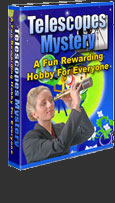
 |
Download FREE "Mystery of Telescopes" Ebook Now! - What do you really want to do with your telescope?
Just type in your name and email address below and we'll send you the ebook instantly |
Introduction to Galileo’s Telescope
 Telescopes
made their mark in the history
almost 400 years back in early 1600’s. The desire to see the stars
and the planets gave rise to the idea of Telescope by a man called Galileo.
Telescopes
made their mark in the history
almost 400 years back in early 1600’s. The desire to see the stars
and the planets gave rise to the idea of Telescope by a man called Galileo.
Almost hundreds of years back, an Italian mathematician; Galileo dreamt
about a mechanical device that could enable him to see stars, planets
and other distant objects in the night and he eventually in 1609 he realized
his dream by making a device which we today name as telescope.
The telescope of Galileo was able to spots on the moon’s surface. At that time, Galileo knew that he has done something that will be remembered forever. When he invented his telescope, he knew that has certainly made a history.
But soon, he made his findings as public by publishing them in a bulletin called as Message from the Stars. After his invention was revealed in front of the world, humanity came to know about their earth’s surroundings and neighbours.
Although the telescope made by Galileo was very simple in comparison with the one that are in use today but Galileo’s telescope provided the basic principles that are still in use. Galileo telescope was a tube light device with two lenses; the convex and the concave lens.
Convex lens are curved towards outside and concave lenses are curved
towards inside. The concave lens was used as an eye-piece. Galileo was
inspired by one of the invention of his time; spy glasses that were used
to examine closely different enemy camps by the militants.
The main principle of Galileo’s telescope, and almost all of telescopes available today, was the combination of two lenses in order to gather more light. Human eye also acts as a lense but it can’t gather that much light.
The two lenses are used in telescopes that enable it to gather more light. According to the principle, the two lenses would gather the light and would focus the gathered light to build an image.
This image is formed due to refraction which is the reason that sometimes these telescopes are also called as the refractors or refracting telescopes. The term refracting, in the context of telescope, means the bending of the gathered light in order to form its image.
Galileo’s telescope was able to magnify an object about 30 times. The image made by the Galileo’s telescope was, however, distorted and blurred because of the shape of the lens.
Even then the Galileo’s telescope was one of the most exciting tools to view the night sky. Whenever you get success and fame, as a bonus, you get new enemies.
Some people said that planets can’t be seen with naked eye so there is no point in exploring them. Other said that it is only giving illusions to the people. Galileo kept on working hard and didn’t bother by these criticisms.
Another criticism that Galileo’s telescope faced was that the findings of the Galileo’s telescope was considered to be controversial since it was helping in proving the belief of Catholics Church that the Sun is in the centre of the Universe, not the earth.
Galileo’s telescope is also considered to be the father of all other telescopes since all telescopes evolved from Galileo’s telescope.
The principle that Galileo gave for his telescope are still used in the
development of modern telescopes. Without Galileo’s telescope we
wouldn’t have today’s modern telescopes that have enabled
us to know about our earth and its surrounding.